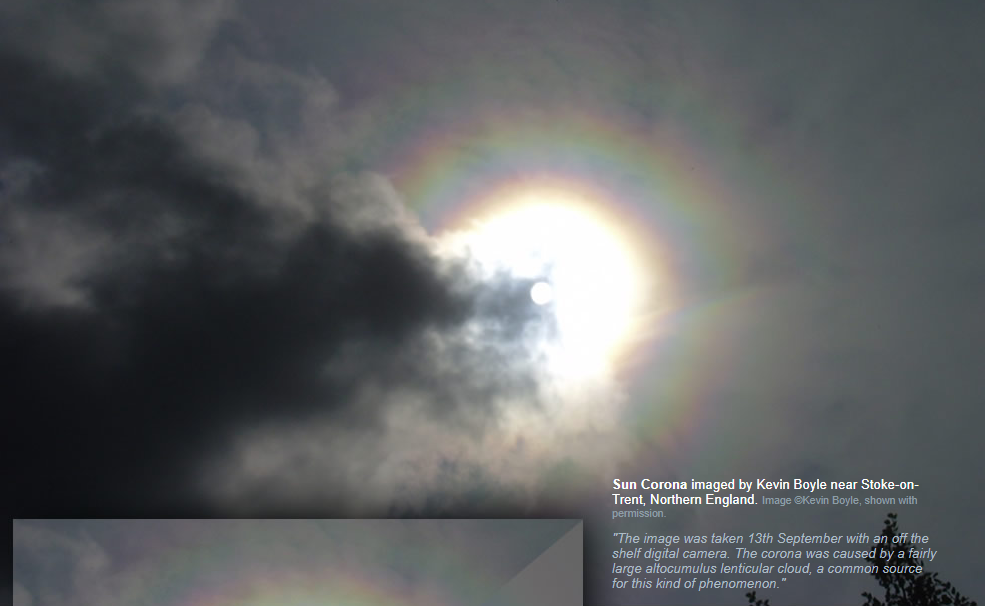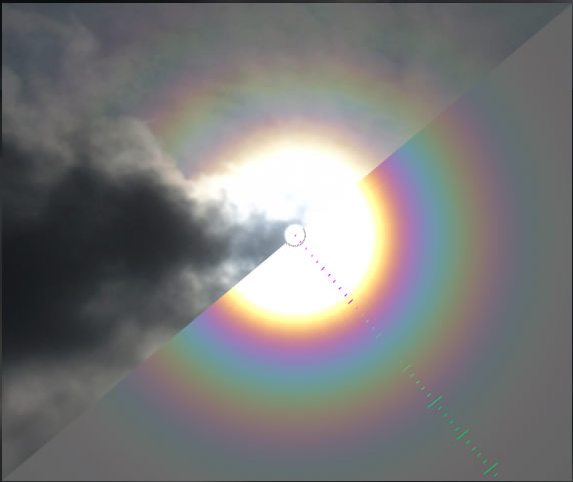Sun Corona
The Fascinating Phenomenon of Sun Corona
Have you ever gazed up at the sky and noticed a beautiful ring of light encircling the sun? This captivating sight is known as a Sun Corona, and it occurs when light is diffracted by small droplets in the atmosphere. While coronae are not uncommon, there are certain characteristics that make some of them truly exceptional.
One remarkable example of a Sun Corona was captured in an image taken by Kevin Boyle near Stoke-on-Trent, Northern England. The photograph showcases three distinct rings, indicating that the droplets responsible for the corona were all of very similar size. This is quite extraordinary, as droplets in clouds typically vary in size. The corona in this image was caused by a fairly large altocumulus lenticular cloud, a common source for this type of atmospheric phenomenon.
The Sun Corona image is also notable because it captures the sun's disk, which is usually lost in overexposure. The presence of the sun's disk allows for measurements of the corona's angular size and estimation of the droplet size that created it. By comparing the corona in the image with a simulation made using an exact Lorenz-Mie calculation in IRIS, it was determined that the droplet diameter was approximately 15 microns (15/1000 mm). This falls within the typical range of cloud droplet sizes, which can range from 1 to 100 microns in diameter.
To fully appreciate the significance of this Sun Corona image, it is important to understand the formation process behind this atmospheric optical phenomenon. Lenticular clouds, such as the altocumulus cloud in this case, play a crucial role. These lens-shaped clouds are formed by moist air flowing over elevated terrain features, such as mountains. As the air rises and cools, it reaches its dew point and condenses into visible cloud droplets. These droplets then rapidly form and evaporate within the lenticular cloud, resulting in droplets of similar size.
The uniformity in droplet size within the altocumulus lenticular cloud is what sets this Sun Corona apart. When sunlight passes through these droplets, it undergoes diffraction, causing the rings of light that form the corona. In this case, the three rings indicate that the droplets were remarkably consistent in size. This level of uniformity is a rarity and adds to the allure of this particular atmospheric phenomenon.
It is worth noting that while this image provides valuable insights into the Sun Corona, it is not an isolated occurrence. Coronae can be observed in various atmospheric conditions and with different cloud types. They are not exclusive to altocumulus lenticular clouds. Other cloud types, such as cirrus clouds, can also produce coronae when the conditions are right.
The study of atmospheric optics continues to intrigue scientists and photographers alike. The ability to capture and analyze images like the one taken by Kevin Boyle allows for a deeper understanding of the intricate processes that occur in our atmosphere. As technology advances, we can expect to unravel more secrets about coronae and other atmospheric phenomena, enhancing our appreciation for the wonders of the natural world.
In conclusion, the Sun Corona is a captivating atmospheric phenomenon that occurs when light is diffracted by small droplets in the atmosphere. The image captured by Kevin Boyle near Stoke-on-Trent, Northern England showcases an exceptional example of a Sun Corona with three distinct rings. The uniformity in droplet size within the altocumulus lenticular cloud responsible for this corona adds to its uniqueness. By studying images like these, we can gain valuable insights into the processes that shape our atmosphere and deepen our appreciation for the beauty of nature's optical displays.

Sun Corona imaged by Kevin Boyle near Stoke-on-Trent, Northern England. Image ©Kevin Boyle, shown with permission.
"The image was taken 13th September with an off the shelf digital camera. The corona was caused by a fairly large altocumulus lenticular cloud, a common source for this kind of phenomenon."
Coronae are produced when light is diffracted by the small droplets of clouds. This one is exceptional in that three rings are visible, indicating that the droplets were all of very similar size. Droplets form and then evaporate rapidly in lenticular clouds, a factor producing similar drop sizes because all the droplets have identical histories.
The image is also exceptional in that the sun's disk is visible. Usually it is lost in overexposure. The disk, 0.5° diameter, lets us measure the corona angular size and then estimate the size of the droplets making it. The inset image compares the corona with a simulation made by an exact Lorenz-Mie calculation in IRIS. The corona is reasonably matched (its rings are slightly non-circular) using a droplet diameter of 15 micron (15/1000 mm). This is well within the 1-100 micron diameter range of cloud droplets.

Note: this article has been automatically converted from the old site and may not appear as intended. You can find the original article here.
Reference Atmospheric Optics
If you use any of the definitions, information, or data presented on Atmospheric Optics, please copy the link or reference below to properly credit us as the reference source. Thank you!
-
<a href="https://atoptics.co.uk/blog/sun-corona/">Sun Corona</a>
-
"Sun Corona". Atmospheric Optics. Accessed on December 4, 2024. https://atoptics.co.uk/blog/sun-corona/.
-
"Sun Corona". Atmospheric Optics, https://atoptics.co.uk/blog/sun-corona/. Accessed 4 December, 2024
-
Sun Corona. Atmospheric Optics. Retrieved from https://atoptics.co.uk/blog/sun-corona/.